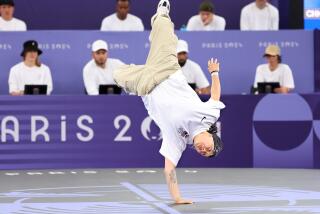A Native Treasure to Behold
- Share via
When Kristi Yamaguchi, as lovely an emissary as we have ever sent, won the Olympic gold in figure skating for the United States at Albertville, it immediately brought the fanatic nationalists out of the woodwork. They thought some Japanese-bashing was in order. But it blew up in their faces when it turned out Kristi was a fourth-generation American. Her family was here when some of theirs were still picking olives or stomping grapes or digging peat in other parts of the world.
Kristi was as American as a pumpkin. Or a Valley girl. She chewed gum, collected rock albums, ate pizza and was on the telephone a lot.
On the ice she is the nearest thing to a living poem as an athlete gets. Off the ice, she goes to malls, checks fashions and worries about her hair. When she picks music for her routines, she doesn’t turn to Madame Butterfly, she chooses the pop group, En Vogue, whoever they are.
America is lucky to have her. She says the right things, does the right things and her performance on ice is so flawless she got 99.9 points out of 100 in the World Professional Skating Championships at Landover, Md., the other night. She is the first American woman since 1976 to win the Olympic gold. Until Kristi, the sport had pretty much belonged to Germany’s Katarina Witt.
Figure skating is the most graceful and balletomanic of sports. It has an unworldly, fairy-tale aura. It is the only sport scored by Tchaikovsky and choreographed by Balanchine. It owes a great deal to the Norway’s Sonja Henie, who not only put the sport on Page 1 but in the movies, as well. Sonja got so rich making flicks like “Sun Valley Serenade” that she had more ice around her neck than under her skates. She married more rich men than Zsa Zsa.
Before Sonja, figure skating was a boring exercise in precision ice sculpture in which the contestant skated in a series of precise figure eights, heavily bundled against the cold and judged by grave, bearded technicians who took micrometers to measure the scratchings in the rink surface.
Gradually, these “school figures” were augmented by a more uninhibited form of ice dancing that put some show-biz into the sport and made it look less like five guys in search of a collar button and more like a Broadway musical. Henie pioneered this. An attractive blonde who, among other things, was Hitler’s favorite athlete, she took the sport out of the slide rule, tape-measure monotony and put it in footlights. She also took it out of the overcoats and put in into, so to speak, a bikini. Or spangled lingerie.
The school figures, until recently, still counted for as much as 40% of the total score.
Kristi Yamaguchi doesn’t have the pesky figure-eights to plod through. The only compulsories these days are a set of freestyle maneuvers. Choreographers are more important than blades in today’s version of the sport.
Kristi, whose father is a dentist, took up the sport almost by accident. Her older sister dabbled in figure skating and brought Kristi along. Kristi was on ice skates almost as soon as she was in shoes.
She was never on natural ice in her life. Fremont, Calif., doesn’t get that cold. But she was soon the darling of the rinks and a sure bet for stardom. Kristi first tried pairs (i.e., dance) skating with a partner, Rudi Galindo. They won the U.S. championship two years in a row and then she decided to strike out on her own. She won the World women’s championship in 1991 and 1992 and the Olympics this year.
They name ice routines after half-forgotten icemen who first perfected them--an “Axel” or a “Salchow” signifies a difficult spin move that has to be executed perfectly to attract high scores. Nobody can spin in the air the way an athlete leaping off ice can.
Figure skating was one of the few Olympic sports where an athletic talent could be converted into an entertainment career. But usually that entailed skating around in an Ice Follies in a bunny costume to the strains of “Sleeping Beauty.”
The skaters still do that. Kristi will shortly join the tour of Stars on Ice. But, now, there are professional competitions, as well. And, tonight at the Forum, for the first time in its 12-year history, a skating Super Bowl of past and present Olympic and world medalists will compete in the event called the DuraSoft Challenge of Champions.
At 5 feet and 93 pounds, Kristi looks as if she arrived at the rink by pram. But, she is able to vote and go to R movies if she so desires. She’s 21, looks 12, but on ice is a ballerina of such extraordinary grace and beauty, she appears winged.
She can qualify for the 1994 Lillehammer Olympics by applying for amateur reinstatement by April. The Olympic Committee hopes she does. Her country needs her. So does her state. It’s not every day you get a chance to get represented in an Olympics by a member of one of the first families of California.
More to Read
Go beyond the scoreboard
Get the latest on L.A.'s teams in the daily Sports Report newsletter.
You may occasionally receive promotional content from the Los Angeles Times.






